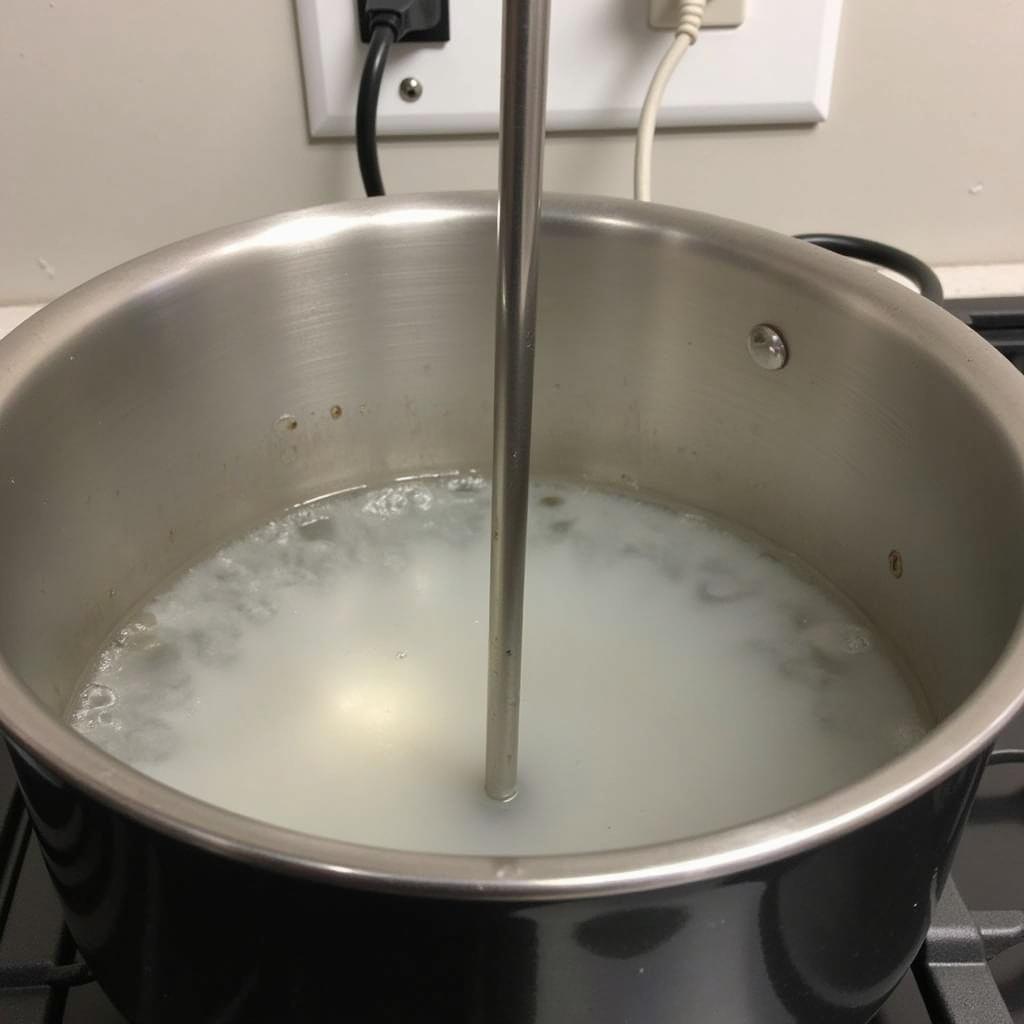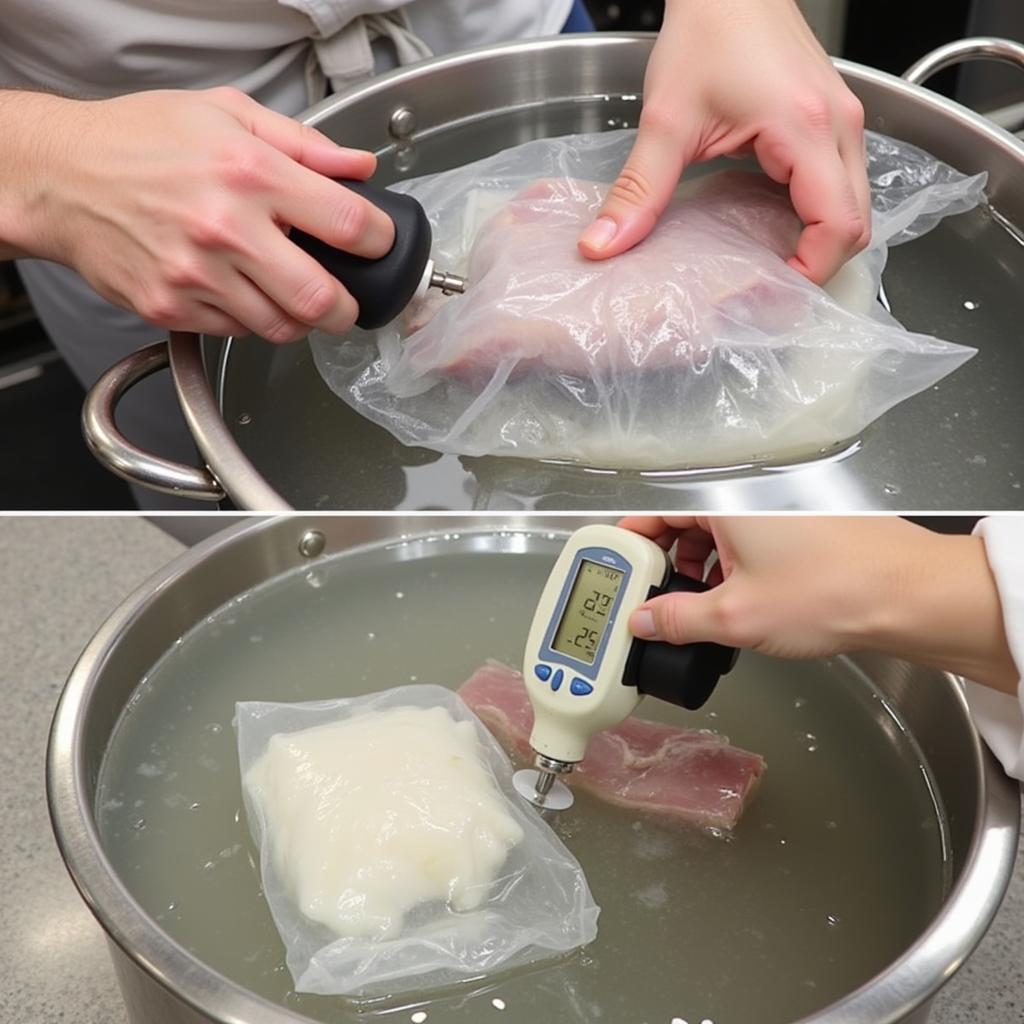An Immersion Heater For Food might sound like something out of a sci-fi novel, but it’s actually a practical and versatile tool found in kitchens worldwide. Whether you’re a seasoned chef or just starting your culinary journey, understanding the ins and outs of this handy device can open up a world of possibilities for convenient and efficient cooking.
 Immersion heater submerged in a pot of water
Immersion heater submerged in a pot of water
What Exactly is an Immersion Heater for Food?
In essence, an immersion heater for food is a portable heating element that is submerged directly into the liquid you want to heat. Think of it as an electric kettle without the kettle. It works by converting electrical energy into heat, raising the temperature of the surrounding liquid efficiently and rapidly.
Benefits of Using an Immersion Heater for Cooking
You might be wondering, why use an immersion heater when you have a stovetop? Well, here are some compelling reasons:
- Speed and Efficiency: Immersion heaters are known for their rapid heating capabilities. They can bring water to a boil faster than most stovetop methods, saving you precious time in the kitchen.
- Energy Savings: Their direct heating method minimizes heat loss, making them more energy-efficient than traditional stovetop cooking.
- Portability and Convenience: Immersion heaters are compact and easy to store, making them ideal for small kitchens, dorm rooms, or travel. Imagine making instant soup in your hotel room or quickly heating up leftovers at the office – the possibilities are endless!
- Precision Heating: Many models come equipped with adjustable temperature settings, allowing for precise control over your cooking process. This is particularly useful for delicate tasks like tempering chocolate or maintaining a consistent temperature for sous vide cooking.
Safety First: Using Your Immersion Heater Responsibly
While incredibly convenient, it’s crucial to prioritize safety when using an immersion heater for food:
- Always Submerge: Never turn on the heater unless it’s fully submerged in liquid. Operating it in the open air can cause overheating and damage to the device.
- Water Level Matters: Ensure the heating element is adequately covered with liquid at all times during operation.
- Hands Off: Avoid touching the heating element or the liquid while the heater is on. Always unplug the device before checking the food or removing it from the liquid.
- Dry Storage: After use, allow the heater to cool completely before storing it away.
Beyond the Boil: Creative Uses for Your Immersion Heater
You can do so much more than just boil water with an immersion heater. Here are some creative culinary applications:
- Perfect Poached Eggs: Achieve perfectly poached eggs with runny yolks and firm whites by gently swirling the water with the heater to create a whirlpool effect before adding the eggs.
- Silky Smooth Sauces: Use the immersion heater to create lump-free sauces and custards directly in the saucepan, eliminating the need for a double boiler.
- DIY Yogurt and Cheese: Maintain the ideal temperature for culturing yogurt or heating milk for cheesemaking with the precise temperature control of an immersion heater.
 Sous vide cooking with an immersion heater
Sous vide cooking with an immersion heater
Choosing the Right Immersion Heater for Your Needs
Not all immersion heaters are created equal. Consider these factors when selecting one:
- Wattage: Higher wattage translates to faster heating. Choose a wattage that suits your needs and the volume of liquid you’ll be heating.
- Temperature Control: Opt for a model with adjustable temperature settings for greater control over your cooking.
- Safety Features: Look for features like automatic shut-off and boil-dry protection for added safety and peace of mind.
Conclusion
An immersion heater for food offers a surprisingly versatile and efficient way to cook a variety of dishes. By following safety precautions and exploring its many uses, you can elevate your culinary game and unlock a world of culinary possibilities, all while enjoying the convenience and efficiency this handy tool provides.
FAQ
1. Can I use an immersion heater in any type of pot?
It’s best to use heat-resistant materials like stainless steel, glass, or enamelware. Avoid using the heater in non-stick cookware, as the high heat could damage the coating.
2. How do I clean my immersion heater?
Never immerse the entire heater in water. Instead, wipe the heating element and cord with a damp cloth after each use.
3. Can I leave an immersion heater unattended?
It’s not recommended to leave any heating appliance unattended while in use. Always stay present and monitor the cooking process.
Still have questions?
Contact our 24/7 customer support team at Phone Number: 02437655121, Email: [email protected] Or visit us at: 3PGH+8R9, ĐT70A, thôn Trung, Bắc Từ Liêm, Hà Nội, Việt Nam. We’re here to help!